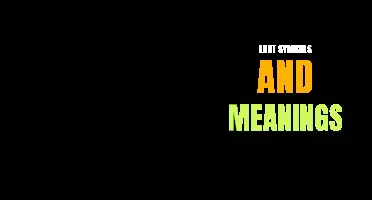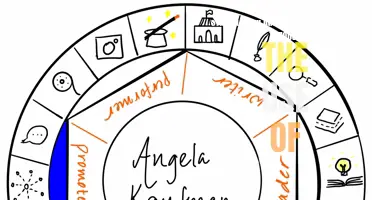
Punctuation symbols may not seem like much at first glance, but they hold the power to transform a sentence, convey emotion, and give words their proper meaning. From the humble period that concludes a thought with a gentle finality, to the exclamation mark that adds excitement and intensity, these symbols are the unsung heroes of effective communication. They help us navigate the complex dance of language, guiding our understanding and lending nuance to our words. So let's dive into the fascinating world of punctuation symbols and explore their hidden meanings!
What You'll Learn

What is the meaning of the period (.) punctuation symbol?
The period (.), also known as a full stop, is a punctuation symbol with various meanings and uses in the English language. It is one of the most frequently used punctuation marks and serves multiple purposes in writing and grammar.
One of the primary functions of the period is to indicate the end of a declarative sentence, which makes a statement or expresses an idea. It marks the completion of a thought or idea and allows the reader to pause before moving on to the next sentence. For example, in the sentence "I went to the store," the period is used to signal the end of the sentence.
Another common use of the period is to abbreviate words or phrases. It is often used to create abbreviations for titles, measurements, or familiar terms. For instance, "Dr." is an abbreviation for doctor, "Feb." is short for February, and "etc." stands for et cetera. The period helps separate the abbreviated form from the rest of the text and indicates that it is an abbreviation.
In addition, the period is used in decimal numbers to separate the whole number part from the decimal fraction. For example, in the number 3.14, the period separates the number 3 from the fraction 14. This use of the period is important in mathematical and scientific contexts.
The period is also used in web addresses or URLs to separate different components. For example, in the URL "www.example.com/page1.html," the period is used to separate the domain name (example) from the top-level domain (com) and the subdirectory (page1.html). It is crucial for specifying the correct location on the internet.
Furthermore, the period is used in abbreviations of citations and references in academic writing. When providing a full bibliography or citing sources within the text, the period is used to indicate the end of each element of the citation. This ensures clarity and consistency in academic writing.
In conclusion, the period punctuation symbol serves multiple purposes in the English language. It indicates the end of a declarative sentence, it is used to abbreviate words or phrases, it separates the whole number from the decimal fraction in decimal numbers, it separates components in web addresses, and it is integral in academic citations. These various uses make the period a vital element of written communication and grammar.
The Symbolic Power Behind Oshun Tattoos: Unveiling the Meaning Behind This Ancient Lwa
You may want to see also

What does the comma (,) punctuation symbol represent?
The comma (,) is a widely used punctuation symbol in the English language. It serves several purposes, including indicating a pause in a sentence, separating items in a list, separating clauses in a sentence, and clarifying meaning in various contexts. Understanding when and how to use commas correctly can greatly enhance one's writing and communication skills.
First and foremost, the comma is used to indicate a pause in a sentence. This helps to break up the flow of words and allows the reader to easily digest the information. For example, in the sentence, "I went to the store, bought some groceries, and returned home," the commas separate the different actions and give the reader a moment to process each step.
Commas are also used to separate items in a list. This is particularly important when listing three or more items in a sentence. For example, "I like apples, oranges, and bananas." The commas here help to differentiate between the three different fruits and make the sentence more organized and readable.
In addition to separating items in a list, commas are used to separate clauses in a sentence. This is especially relevant in complex sentences that contain multiple ideas. For example, "Although it was raining, I decided to go for a walk." The comma after "raining" separates the dependent clause from the independent clause, making it easier to understand the sentence structure.
Commas can also be used to clarify meaning in various contexts. For example, consider the sentence, "Let's eat, Grandma!" Without the comma, the sentence could be interpreted as a command to eat Grandma, but with the comma, it becomes a statement inviting Grandma to join for a meal. This simple punctuation mark can completely change the meaning of a sentence.
While the comma is a versatile punctuation symbol, it is essential to use it correctly. Misplaced or unnecessary commas can lead to confusion and alter the intended meaning of a sentence. It is crucial to follow the rules of comma usage and be aware of common errors, such as the comma splice (using a comma to join two independent clauses without a coordinating conjunction) and the run-on sentence (not using a comma to separate two independent clauses).
In conclusion, the comma is a punctuation symbol that represents several functions in the English language. It indicates a pause in a sentence, separates items in a list, separates clauses in a sentence, and clarifies meaning in various contexts. Understanding how to use commas correctly can greatly improve one's writing and communication skills, leading to clearer and more effective language use.
The Hidden Symbolism Behind iMessage Symbols: Decoding Their Meanings
You may want to see also

How is the exclamation point (!) typically used in writing?
In writing, the exclamation point (!) is used to show strong emotion, emphasis, or surprise. It is a punctuation mark that can change the tone and meaning of a sentence. The exclamation point is often used in exclamatory sentences or interjections to express excitement, joy, anger, or urgency.
One common use of the exclamation point is to indicate excitement or enthusiasm. For example, "I won the lottery!" or "I can't believe it!" These sentences convey a sense of surprise or delight, and the exclamation point emphasizes the strong emotion behind the statement.
Another use of the exclamation point is to convey urgency or emphasis. For instance, "Stop!" or "Watch out!" These sentences are often used in warnings or commands to grab the reader or listener's attention. The exclamation point adds a sense of urgency and emphasizes the importance of the message.
In informal writing, such as text messages or casual emails, the exclamation point is often used to add emphasis or convey a friendly tone. For example, "Thanks!" or "Sure!" These sentences are not necessarily expressing strong emotion but rather adding a touch of enthusiasm or friendliness to the message.
It is important to note that the exclamation point should be used sparingly in formal writing, such as academic papers or business communications. Overusing exclamation points can make the writing feel unprofessional and can dilute the impact of the punctuation mark. Therefore, it is generally recommended to reserve the exclamation point for situations that genuinely require strong emphasis or express strong emotion.
Overall, the exclamation point is a powerful punctuation mark that can add excitement, emphasis, or urgency to a sentence. It is important to use it judiciously and be mindful of the context and tone of the writing. When used correctly and sparingly, the exclamation point can be an effective tool for conveying strong emotions and grabbing the reader's attention.
The Significance and Meaning Behind the TM Symbol
You may want to see also

What does the question mark (?) punctuation symbol signify?
The question mark (?) is a punctuation symbol that is used to indicate a direct question in written language. It is typically placed at the end of a sentence to let the reader know that the sentence is asking a question and requires a response.
One of the primary functions of the question mark is to indicate a sentence that seeks information or clarification. For example, "What is your favorite color?" or "Where did you go on vacation?" In these examples, the question mark signals that the sentences are inquiries and prompts the reader to think about the answers.
In addition to direct questions, the question mark can also be used to signify uncertainty or doubt. For instance, "Are you sure about that?" or "Could you explain further?" In these cases, the question mark conveys a sense of skepticism or a desire for further information.
The question mark is an essential punctuation symbol in written language as it helps to distinguish between declarative statements and interrogative sentences. It plays a crucial role in the overall meaning and tone of a sentence and helps to guide the reader's understanding of the intention behind the words.
When using a question mark, it is important to note that it should only be used at the end of a sentence that is a direct question. It should not be used after indirect questions or sentences that end with a polite request. For example, "I wonder if you could help me" or "Tell me more about yourself, please." In these cases, the sentence structure does not require a question mark because they are not asking a direct question.
In conclusion, the question mark is a punctuation symbol that signifies a direct question in written language. It prompts the reader to think about the answer and denotes a sense of uncertainty or doubt. Understanding how and when to use a question mark correctly is important for clear and effective communication in writing.
Exploring the Profound Symbolic Meaning of Fire: A Guide to Its Mystical Significance
You may want to see also

Can you explain the purpose of the semicolon (;) punctuation symbol?
The semicolon (;) is a punctuation symbol that is used to separate two independent clauses in a sentence. It serves a different purpose than a comma or a period, and when used correctly, it can enhance the clarity and flow of your writing.
One of the main functions of the semicolon is to join two closely related ideas that are independent clauses, meaning they can each stand alone as separate sentences. Instead of separating these two ideas with a period or using a coordinating conjunction like "and" or "but," you can use a semicolon to show that the two ideas are closely connected and should be read together.
For example, consider the following sentence: "I have a meeting at 10; I need to finish this report beforehand." In this case, the two independent clauses, "I have a meeting at 10" and "I need to finish this report beforehand," are related in that the second clause explains why the meeting is important. By using a semicolon instead of a period or comma, the reader understands that the two ideas are connected and should be considered together.
Another function of the semicolon is to separate items in a series when the items themselves contain internal punctuation. Normally, a comma is used to separate items in a list, but if the items themselves contain commas, using semicolons instead can help to avoid confusion.
For example: "The team members present at the meeting were Sarah, the marketing manager; Tom, the sales representative; and Rachel, the financial analyst." In this case, semicolons are used to separate the names of the team members because each name is followed by additional information set off by commas. This helps to clearly define each member and their role.
It is important to note that the use of semicolons should be used sparingly and appropriately. Overusing semicolons can make your writing feel clunky and complicated. Instead, use them when the two independent clauses you are joining are closely related and when using a period or a comma would not accurately convey the intended meaning.
In summary, the semicolon is a punctuation symbol that serves a specific purpose in writing. It is used to join two independent clauses that are closely related and can stand alone as separate sentences. It is also used to separate items in a series when the items themselves contain internal punctuation. By using semicolons correctly and judiciously, you can enhance the clarity and flow of your writing.
Decoding the Mystical Hopi Symbols and Their Profound Meanings
You may want to see also
Frequently asked questions
The period, also known as a full stop, is used to indicate the end of a sentence. It is placed at the end of a complete thought or statement to show that the idea has been completed. For example: "I went to the store."
The comma is a versatile punctuation symbol that is used to indicate a pause in a sentence. It is often used to separate items in a list or to separate clauses in a sentence. For example: "I bought apples, oranges, and bananas."
The exclamation mark is used to show strong emotion or surprise. It is placed at the end of a sentence or phrase to indicate enthusiastic or emphatic statements. For example: "I can't believe it!"
The question mark is used at the end of a sentence to indicate a direct question. It is used to show that the speaker is asking for information or clarification. For example: "What time is it?"







